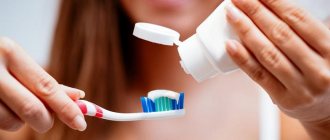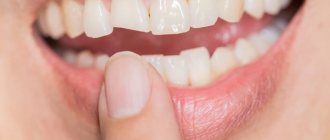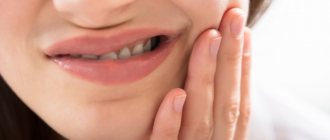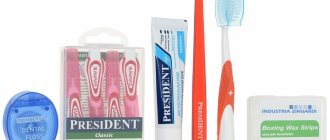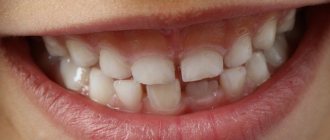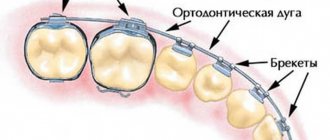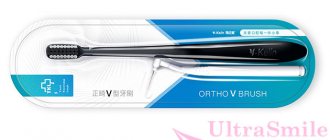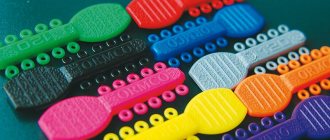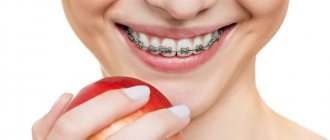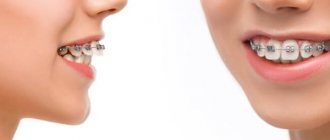Sometimes, after installing braces, a person notices that his teeth have become too mobile. Many people begin to panic and go to the dentist to remove the orthodontic appliance. But in most cases, tooth mobility is normal. In this article we will tell you why teeth become loose after braces and what needs to be done.
In this article
- Changes in the mouth while wearing braces
- Why are teeth loose?
- Why do teeth wobble under braces from an anatomical point of view?
- What to do if teeth become loose under braces?
- Why do you need retainers for loose teeth?
- In what cases is loose teeth not normal?
- Proper care will protect against loose teeth
Changes in the mouth while wearing braces
Installing a brace system to correct a bite or straighten teeth is almost always accompanied by an adaptation period. In some patients it can be several days, in others - a couple of weeks, it depends on the individual characteristics of the body. During the adaptation period, elements of the orthodontic structure can rub the mucous membrane, lead to the formation of ulcers on the inside of the lips and cheeks, and cause discomfort. Patients are warned about possible temporary disturbances in diction and difficulties in pronouncing certain sounds.
But practice shows that many are not prepared for the loosening of their teeth while wearing braces. If a tooth is loose under braces, there is a fear of losing it. Is it really possible to lose loose teeth on which braces are attached? In most cases, unusual mobility is normal and, as long as your dentist recommends it, will not lead to tooth loss.
When mobility occurs after fixation of the system
After installation of the system, the patient experiences unpleasant pulling sensations caused by the pressure of the arc. When wearing braces, slight mobility of individual elements is a completely normal and natural phenomenon. Answering the question of why teeth can become mobile during orthodontic treatment, experts in the field of orthodontics explain that this is due to the peculiarities of the anatomical structure of the dentofacial system.
After installing the braces system, you may feel the teeth move
Incisors, canines and molars are attached to the jawbone by elastic ligaments surrounded by dense connective tissue. The impact of the structure leads to displacement of elements, which reduces tissue density and disrupts the stability of the teeth. The following are signs that the correction is going well:
- slight mobility of elements,
- looseness is observed in the first days after fixation of the structure and persists throughout the entire orthodontic course,
- gums look healthy, there are no signs of inflammation,
- There is no acute piercing pain, and moderate discomfort is not a symptom of pathology.
“I was also scared when I noticed that my teeth had become mobile. But it showed up for me probably a month later. When I pressed a little with my fingers, I clearly felt them wobbling. Not much, but still. I was very scared. But the orthodontist left me her mobile number just in case. I called her immediately, and she calmed me down. There is nothing like that here, that's normal. Of course, if you are very unsteady, it is better to go straight to the doctor. But in my case they became only slightly mobile.”
Vika777, from correspondence on the 32top.ru forum
In most cases, this is normal if there is some mobility. But if you have doubts about the condition of your teeth and gums, seek advice from a specialist. It is better to make sure once again that nothing threatens the health of the oral cavity than to start a pathological process and bring the situation to irreversible consequences.
Why are teeth loose?
To understand the reason why a tooth is loose, you need to know how the braces system works and how it works. The design of the bracket system is such that a small lock is attached to each tooth according to a certain pattern. An orthodontic arch made of shape memory material is installed in the fastenings of each lock. This arch puts pressure on the dentition and promotes tooth movement.
What causes the displacement? Under the influence of a directed load, the bone tissue on one side decreases, the tooth socket expands, which allows the tooth to move to a new location. At the same time, in order for him to sit firmly in a new place, on the other hand, the bone tissue must grow, this process takes time. During the period when the socket has already widened, and not enough new bone tissue has grown, the teeth can be mobile. That is, their mobility during the period of movement is the norm, which should not frighten. The main thing is to fix the tooth in its new place in the jawbone after displacement.
Structure mobility
If you do not properly care for your oral cavity during orthodontic treatment, a situation may arise where the brace structure itself becomes loose, which leads to a feeling of loose teeth.
The reason for this phenomenon may be deformation of the arc or unsticking and displacement of the lock. In some situations, mobility of the elements of the orthodontic system is caused by the falling off of the ring that secures the structure on the distant molars.
If damage to the braces system is detected, you must contact a dentist who will correct the resulting structural defect.
If you cannot visit the clinic in a timely manner, the element that has lost its strong fixation must be secured with orthodontic wax.
You cannot delay a visit to the dentist, since the absence of any elements of the system or their improper fixation entails a change in the distribution of the load on the dentition, which is fraught with serious consequences.
Why do teeth wobble under braces from an anatomical point of view?
Teeth are made up of two main parts—the dental crown (the visible part) and the root. They are connected to each other by a ligament supported by bone tissue. Under the pressure of braces, the tooth tilts, as a result of which the distance between the ligament and the dental crown changes: on the one hand it becomes larger, and on the other, on the contrary, smaller. Special cells - osteoblasts - begin to actively work and restore the missing bone tissue to create a new support for the tooth. Other cells—osteoclasts—perform the opposite job: they promote the resorption of bone tissue where the tooth needs to be moved.
In this way, the pinched connective ligament gradually straightens out, and the tooth can take its correct position. Such cycles of loss and growth of bone tissue are repeated many times during orthodontic correction, contributing to the gradual correction of the dentition.
But the speed of these processes is different: bone tissue is absorbed faster than it grows. This is the main reason why teeth become loose after braces start working.
Possible difficulties when wearing braces
Even significant crooked teeth can be corrected with braces. The duration of treatment depends on the complexity of the situation. Some patients wear braces for three years or even more. During this time, various not very pleasant situations may occur. Braces can rub and interfere with eating. In addition, after installation of a straightening system, teeth may hurt and become loose.
Each qualified specialist should advise the patient regarding possible problems and difficulties while wearing braces. This rarely frightens the patient, because for most the dream of a beautiful smile overshadows all problems.
What to do if teeth become loose under braces?
First of all, you need to contact an orthodontist and make sure that the loosening process is physiological and does not threaten the teeth. If the doctor confirms that everything is in order, then you just need to follow the dentist’s recommendations. In particular, reduce the load on the teeth:
- temporarily avoid solid foods (carrots, apples, nuts, caramels, seeds);
- exclude chewing gum, toffees, corn flakes, dried fruits and other foods that stick to the teeth;
- do not bite nails or pencils;
- follow a “soft” diet, which includes mainly liquid and puree dishes (porridge, pates, smoothies, vegetable and fruit purees).
Following these recommendations will not only prevent the loss of mobile teeth, but will also protect the braces from damage. For accelerated bone tissue regeneration, it is important that the diet contains protein products and a full range of essential minerals and vitamins.
Factors for concern
Other reasons can also cause molars to become loose during orthodontic treatment. Due to insufficiently thorough oral hygiene and non-compliance with some of the dentist’s recommendations, diseases such as periodontitis, gingivitis, and periodontal disease may develop during this period.
These pathologies entail inflammation of the periodontium, which is caused by weakening of the roots of the teeth and their loosening.
An equally serious disease is osteomyelitis, which develops as a result of untimely treatment of carious lesions. In this case, a person faces not only loose teeth, but also their loss, as well as the spread of the disease to surrounding tissues and organs.
In parallel with mobility, a person is usually worried about such signs as swelling and bleeding of the gums, carious lesions of the enamel.
The combination of these symptoms requires immediate contact with the dentist to take therapeutic measures.
Find out more about what you need for braces - what devices and products.
In this article we will talk about the pros and cons of wearing braces.
At this address https://orto-info.ru/sistemyi-vyiravnivaniya-zubov/breketyi/do-kakogo-vozrasta-stavit-mozhno-rekomendatsii.html we will tell you up to what age you can get braces to straighten your teeth.
Why do you need retainers for loose teeth?
After removing the braces, in most cases it is necessary to wear a special orthodontic mouthguard, or retainer. Its main function is to fix and hold the teeth in the correct position until the process of regeneration of new bone tissue is completely completed. If you neglect to wear a retainer, your teeth may return to their original place after the braces are removed.
The retention period when it is necessary to wear a mouth guard lasts approximately 2 times longer than the period of wearing braces. On average it is 3-4 years. During this time, the process of bone tissue restoration should be completely completed, the teeth will completely stop loosening and will remain securely in their new place.
What to do if your teeth are loose with braces
The appearance of obvious signs of pathological mobility under braces should at least alert you and become a good reason to urgently contact an orthodontist. The specialist will conduct a visual examination, assess the degree of looseness and the condition of the soft tissues, and, if necessary, prescribe additional diagnostic measures, including an X-ray examination.
If your teeth are loose in braces and there are clear signs of a problem, your doctor will remove the plates and provide appropriate treatment. The vector of therapy will depend on what exactly provoked the pathological process. The patient may be prescribed antibacterial agents and antibiotics, the procedure of Prof. hygiene to remove plaque and deposits, splinting by fixing a fiberglass splint. It will be possible to continue orthodontic correction only after strengthening the dentogingival bonds and ensuring that the source of the problem is eliminated.
It is impossible to get rid of mobility on your own. This requires qualified medical care.
In what cases is loose teeth not normal?
Rarely, there are situations when the cause of tooth loosening is not in the physiological process of resorption and growth of bone tissue, but in some kind of disease.
For example, teeth may become loose if a patient develops osteomyelitis or osteoporosis. Also a common cause of pathological loosening is periodontal disease in the acute stage. Teeth become mobile due to gingivitis, periodontal disease, and periodontitis.
And if bone pathologies arise on their own, then periodontal diseases are most often caused by insufficient hygienic oral care and braces.
In any case, to exclude pathology of the bones or gums, at the first sign of loose teeth, you should consult a dentist. The doctor will conduct a full diagnosis, determine why the teeth are loose and, depending on the results of the examination, prescribe treatment or give recommendations.
When teeth don't move according to plan
In some cases, during dental correction, mobility increases abnormally due to the development of osteomyelitis, osteoporosis or exacerbation of periodontal diseases (gingivitis, periodontitis and periodontal disease).
No one is immune from the development of diseases of the skeletal system. But problems with gums can result from insufficient care of braces and the oral cavity or unprofessional diagnosis at the preparatory stage. Before installing an orthodontic device, gingivitis must be treated, and periodontal disease and periodontitis must be transferred to a stage of stable remission.
In any case, the attending physician will do everything possible to eliminate the problem and minimize its consequences.
Proper care will protect against loose teeth
One of the causes of loose teeth is periodontal tissue disease. To prevent their development, you need to properly care for your mouth while wearing an orthodontic appliance.
Proper care involves daily brushing of teeth with 3-4 types of brushes - regular, special orthodontic with a V-shaped bristle, single-tuft and brush-brush. These devices are used alternately, gradually removing all dirt and plaque. After brushing your teeth, you need to clean the interdental spaces using superfloss - a special orthodontic dental floss. At the final stage, the oral cavity and the braces system are cleaned using an irrigator. This device directs a powerful stream of water, which removes dirt from interdental spaces, periodontal pockets and other difficult areas. To care for braces, it is important to purchase irrigators with special orthodontic attachments.
Careful and regular oral care will prevent pathological loosening of teeth under braces and avoid their loss.
When is it time to sound the alarm?
Sometimes, in parallel with the course of orthodontic treatment, patients develop an inflammatory process, leading to disruption of the ligamentous apparatus and loosening of the elements. The main signs of the pathological condition are listed below:
- swelling and redness of the gums, bleeding,
- carious cavities,
- the appearance of erosions, ulcers and suspicious neoplasms on the surface of the mucosa,
- pathological abrasion of enamel,
- severe pain in certain areas of the jaw arch,
- unpleasant odor and purulent discharge.
You should be concerned when swelling and inflammation of the gums occur.
The above symptoms indicate the development of dental diseases that require immediate treatment. For example, redness and swelling of the gums may indicate gingivitis or periodontitis. Bruxism leads to abrasion of the enamel, and halitosis and purulent discharge are characteristic signs of periodontitis and periostitis. According to experts and statistics, loosening of teeth under braces most often results from poor oral hygiene, neglect of the rules of wearing orthodontic appliances, and injury to the jaw1.
After removing the products
After removing the braces from the mouth at the end of the orthodontic treatment process, the patient may also experience a feeling of loose teeth. This is explained by the fact that without the pressure of the locks, the teeth tend to return to their original position.
At the same time, the tissue surrounding the ligamentous apparatus is quite plastic, so in the absence of restraining devices, the bite can deteriorate again.
Dentists insist on the need to wear special structures of a removable or non-removable type that hold teeth and ligaments in the required position - these are retainers.
The duration of wearing the devices depends on several factors - the patient’s age, the complexity of the corrected pathology, and the characteristics of the body.
As a rule, the minimum duration of the retention period is one year. In some cases, you will have to wear retainers for the rest of your life.
The video shows the mechanism for correcting bites and straightening teeth with braces.
Folk remedies to prevent loosening
The right thing to do if you notice problems with your braces is to visit an orthodontist. But, if there is a lot of time left before the visit, you can help yourself with some folk remedies. Various herbs and home remedies are used for this, but toothpaste is the best one.
You should squeeze the paste onto your toothbrush as if you were brushing your teeth normally and drop some essential oil on it (one drop will be enough). It is a natural antiseptic that is often used to protect gums from inflammation. You should brush your teeth with this solution at least twice a day.
Let's look at other folk tricks:
- Licorice root reduces plaque formation on teeth;
- Massaging the gums using turmeric, black pepper and alum helps a lot;
- Blueberry roots and hawthorn berries significantly strengthen teeth.
What do orthodontists recommend doing to reduce looseness?
Disease prevention is the best way to prevent loose teeth. To do this, it is important to watch what you eat. It is important to have a balanced and complete diet, as well as the right amount of minerals and important nutrients. It is important that nutrition helps strengthen the body as a whole, strengthens the immune system and resists viral infections.
The diet must contain foods containing calcium. These are beans, asparagus, beans, lentils, kefir, cottage cheese. Vitamin C is also very important, which oranges, tangerines, lemons, broccoli and sauerkraut are abundant in.
The oral cavity must certainly be in a healthy condition. Thorough cleaning at least twice a day with special brushes and rinses is important.
If there is loosening, a specialist may recommend special therapy. First, the teeth are cleaned of plaque, and then a splint is placed on the dentition (a metal wire that is attached to the back of the dentition).
